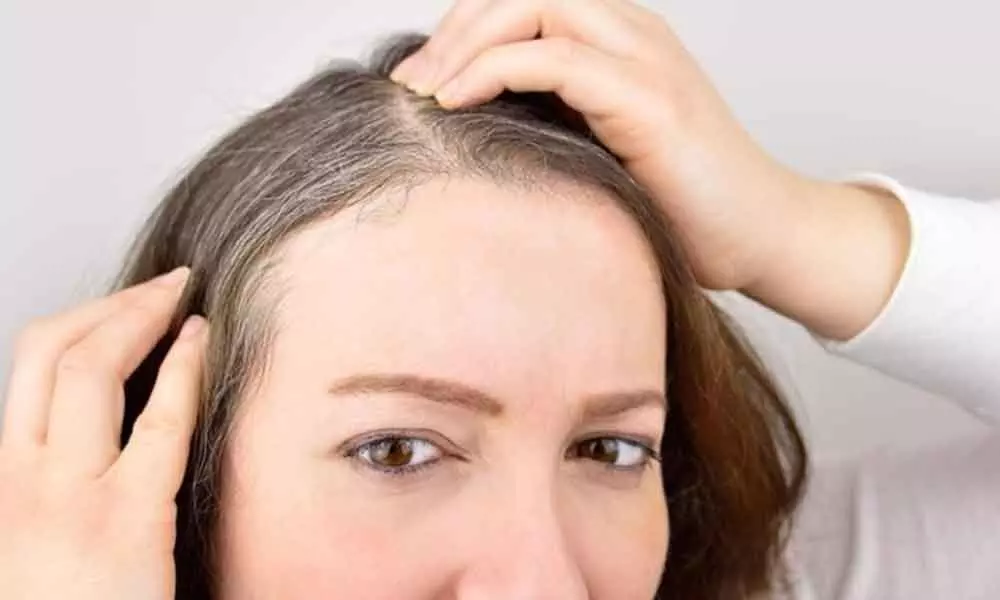Live
- Pakistan Protests: PTI Supporters March Towards Islamabad, Demanding Imran Khan's Release
- Additional Collector Conducts Surprise Visit to Boys' Hostel in Wanaparthy
- Punjab hikes maximum state-agreed price for sugarcane, highest in country
- Centre okays PAN 2.0 project worth Rs 1,435 crore to transform taxpayer registration
- Punjab minister opens development projects of Rs 120 crore in Ludhiana
- Cabinet approves Atal Innovation Mission 2.0 with Rs 2,750 crore outlay
- Centre okays Rs 3,689cr investment for 2 hydro electric projects in Arunachal
- IPL 2025 Auction: 13-year-old Vaibhav Suryavanshi becomes youngest player to be signed in tournament's history
- About 62 lakh foreign tourists arrived in India in 8 months this year: Govt
- IPL 2025 Auction: Gujarat bag Sherfane Rutherford for Rs 2.60 cr; Kolkata grab Manish Pandey for Rs 75 lakh
Just In

Researchers have identified for the first time the mechanism by which chronic stress causes hair colour loss, an advance that may lead to the development of novel drugs which can prevent the whitening of hair.
Researchers have identified for the first time the mechanism by which chronic stress causes hair colour loss, an advance that may lead to the development of novel drugs which can prevent the whitening of hair.
In the study, published in the journal Nature, the scientists induced intense pain in special black mice for several weeks using a substance called resiniferatoxin and turned the animals' fur completely white. "For the longest time it's been said that stress makes the hair turn white but until now there was no scientific basis for this belief.
Our study proved that the phenomenon does indeed occur, and we identified the mechanisms involved," said Thiago Mattar Cunha from Harvard University in the US. "In addition, we discovered a way of interrupting the process of hair colour loss due to stress," Cunha said. The researchers said resiniferatoxin, which activated sensory nerve fibres, is a naturally occurring chemical found in resin spurge (Euphorbia resinifera) - a cactus-like plant native to Morocco. According to the scientists, the sympathetic nervous system, which triggers the body's rapid involuntary response to dangerous situations, is affected directly by the stress, and consists of nerves that branch from the spine and run throughout the body.
It controls the organism's "fight or flight" response to sudden danger, launching a flash flood of the hormones adrenaline and cortisol to make the heart beat faster, blood pressure rise, respiration accelerate and the pupils dilate, among other systemic effects, they added. The researchers observed that when the sympathetic nervous system was blocked, hair whitening was curbed.
"After injecting resiniferatoxin into the mice, we treated them with guanethidine, an anti-hypertensive capable of inhibiting neurotransmission via sympathetic fibers. We observed that the process of fur colour loss was blocked by the treatment," Cunha said. In another experiment, in which the researchers surgically removed the sympathetic fibres, fur colour was again retained in the weeks following pain induction. "These and other experiments conducted by our group demonstrated the participation of sympathetic innervation in achromotrichia and confirmed that pain is a powerful stressor in this model.
But it remained to detail the mechanisms involved," Cunha said. Earlier studies had found that pain-related stress was also involved in the development of hair and skin pigment producing cells called melanocytes. Scientists had discovered that unspecialised stem cells in the hair follicle bulb "mature" too soon under stress. "In a young individual the cells are undifferentiated, like all stem cells, but with ageing, they gradually differentiate. Once the process is complete they stop producing the melanocytes which produce melanin," Cunha said.
"We used various methodologies to show that intense sympathetic activity speeds up differentiation significantly. In our model, therefore, pain accelerated the ageing of melanocyte stem cells," he added. Few days into the study, the researchers found that all of the pigment-regenerating stem cells were lost.
When the researchers compared the genetic activity of mice which received the injection of resiniferatoxin, developing pain, stress and fur colour loss, with those of mice injected with a placebo, they found that a gene which played a role in producing the cell division-related protein called CDK (cyclin-dependent kinase) was involved. In a follow up experiment when the researchers treated mice with a CDK inhibitor, they found that melanocyte stem cell differentiation, along with fur colour loss was prevented. "This finding shows that CDK participates in the process and could, therefore, be a therapeutic target," Cunha said. "It's too soon to know whether it will actually become a target someday in clinical practice, but it's worth exploring further," he added.

© 2024 Hyderabad Media House Limited/The Hans India. All rights reserved. Powered by hocalwire.com







